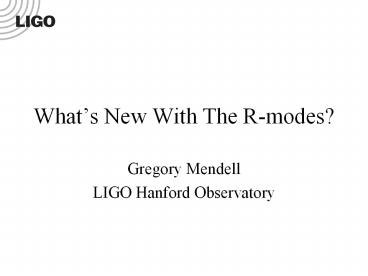What
Title:
What
Description:
What's New With The R-modes? Gregory Mendell. LIGO Hanford ... Have really intense magnetic fields (1012 Gauss) ... Wu, Matzner, and Arras, astro-ph/0006123 ... –
Number of Views:23
Avg rating:3.0/5.0
Title: What
1
Whats New With The R-modes?
- Gregory Mendell
- LIGO Hanford Observatory
2
Neutron Stars are
- Really compact (2GM/Rc2 .2)
- Spin really fast (Up to 2000 Hz? Fastest known
642 Hz) - Have really intense magnetic fields (1012 Gauss)
- Cool from a birth temperature of 1011 K to 109 K
in 1 year - Form a solid crust for T lt 1010 K (30 s after
birth if no heating occurs)
3
Neutron Stars
4
Gravitational-radiation Driven Instability of
Rotating Stars
- GR tends to drive all rotating stars unstable!
- Internal dissipation in the star can suppress the
instability
?
?
5
Ocean Wave Instability
Wind
Current
6
(No Transcript)
7
(No Transcript)
8
(No Transcript)
9
(No Transcript)
10
?
?
11
?
?
12
?
13
?
14
?
?
15
Gravitational-radiation Driven Instability of
Rotating Stars
- GR tends to drive all rotating stars unstable!
- Internal dissipation in the star can suppress the
instability
?
?
16
The R-modes
- The r-modes corresponds to oscillating flows of
material (currents) in the star that arise due to
the Coriolis effect. - The current pattern travels in the azimuthal
direction around the star as exp(i?t im?) - For the m 2 r-mode
- Phase velocity in the corotating frame -1/3 ?
- Phase velocity in the inertial frame 2/3 ?
17
Courtesy Lee Lindblom
18
Courtesy Lee Lindblom
19
R-mode Instability Calculations
- Gravitation radiation tends to make the r-modes
grow on a time scale ?GR - Internal friction (e.g., viscosity) in the star
tends to damp the r-modes on a time scale ?F - The shorter time scale wins
- ?GR ? ?F Unstable!
- ?GR ? ?F Stable!
20
Key Parameters to Understanding the R-mode
Instability
- Critical angular velocity for the onset of the
instability - Saturation amplitude
21
Magnetic Effects on Viscous Boundary Layers
- Previously it has been shown that viscous
boundary layer damping is the most important
suppression mechanism of the r-modes in neutron
stars with a solid crust (Bildsten and
Ushomirsky, ApJ 529, L33 (2000) - Magnetic effects on the viscous boundary layer
were expected to be important at high
temperatures.
22
Viscous Boundary Layers
23
Add Magnetic Field
B
24
Magneto-viscous Boundary Layer With Alfven Waves
25
?
26
(No Transcript)
27
(No Transcript)
28
(No Transcript)
29
(No Transcript)
30
MVBL Critical Angular VelocityMendell
gr-qc/0102042
B 1012
B 1011
B 1010
B 0
31
SaturationLindblom, Owen, Ushomirsky, Phys. Rev.
D 62, 084030 (2000)Wu, Matzner, and Arras,
astro-ph/0006123
- Simple definition of the saturation amplitude ?
maximum value of the perturbed velocity /
equilibrium velocity at the surface of the star - Heat generated by in a turbulent VBL melts the
crust when ? 5.6 X 10-4 (? /?o)-1 - Turbulence in the VBL causes the mode to saturate
when ? 0.015 (? /?o)5 - Crust melts only if ? /?max gt 0.87 (MVBL heating
should lower this number.)
32
Self-organized Pack Ice in the Presence of the
R-modeLindblom, Owen, Ushomirsky, Phys. Rev. D
62, 084030 (2000)
- If a solid crust forms, heat in the VBL melts the
crust (for sufficiently large ?) - If the crust melts, neutrino cooling lowers the
temperature below the melting temperature - Thus, chunks of crust will self-organize (by
adjusting their size) until the heating rate
equals cooling rates. - The star continues to spin down until pack ice
dissipation suppresses the instability. For ?
1 the star spins down to ? /?o 0.093
33
R-mode Movie
See http//www.cacr.caltech.edu/projects/hydrlig
o/rmode.html Lee Lindblom, Joel E. Tohline and
Michele Vallisneri (2001), Phys. Rev. Letters 86,
1152-1155 (2001). Computed using Fortran 90 code
linked wtih the MPI library on CACRs HP Exemplar
V2500.
34
Remaining Questions
- Superfluid case (T ? 109 K)?
- Alfven waves are replaced cyclotron vortex waves
otherwise results could be similar, but it
depends how vortices pin at crust-core interface - Nonlinear winding of magnetic field lines
- Mode coupling to g-modes and other saturation
effects - Semi-rigid crust
35
The R-modes Some New Results
- Greg Mendell, LIGO Hanford Observatory
Log(knowledge)
Learning Curve
Log(time)
?
Mar 9 2001 Start planning talk for LHO
Mar 14 2001 Start learning how to write search
code
Enhanced LIGO detects r-modes































